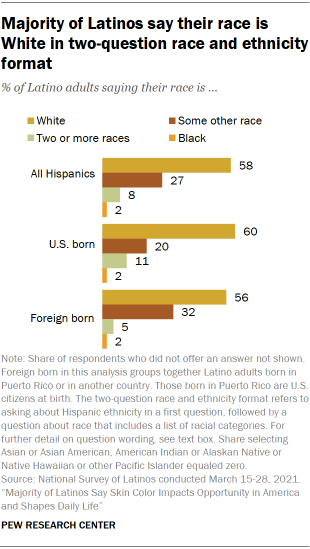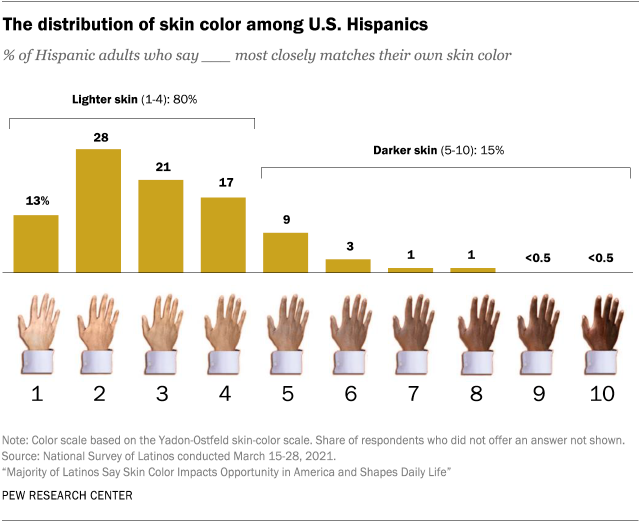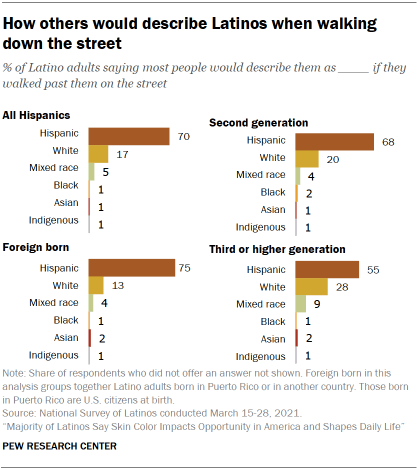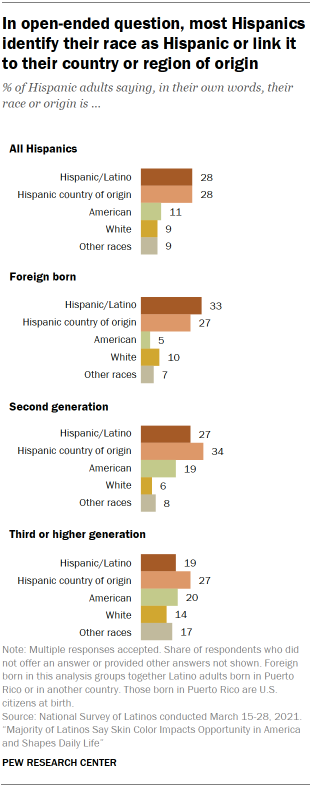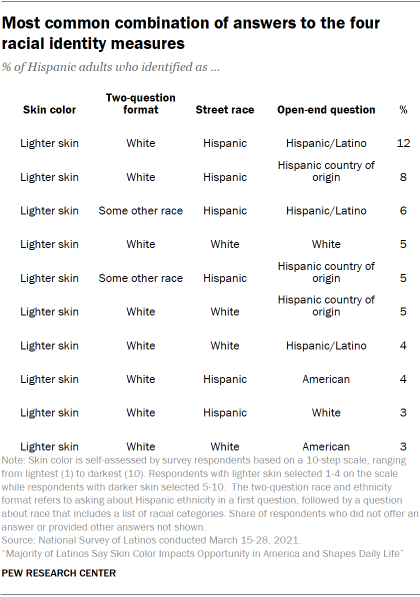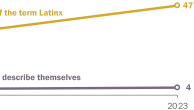How we measured racial identity among Hispanics
The survey used the following four questions to assess the racial identity of Latinos:
What is your race or origin?
- White
- Black or African American
- Asian or Asian American
- Two or more races
- Some other race or origin
How would most people describe you, if, for example, they walked past you on the street? Would they say you are …
- White
- Hispanic or Latino
- Black or African American
- Asian or Asian American
- Native American or Indigenous (the native peoples of the Americas such as Mayan, Quechua or Taino)
- Native Hawaiian or other Pacific Islander
- Mixed race or multiracial
- Other ____
In your own words, if you could describe your race or origin in any way you wanted, how would you describe yourself?
Which of these most closely matches your own skin color, even if none of them is exactly right? (If this question makes you uncomfortable, you may skip it.)
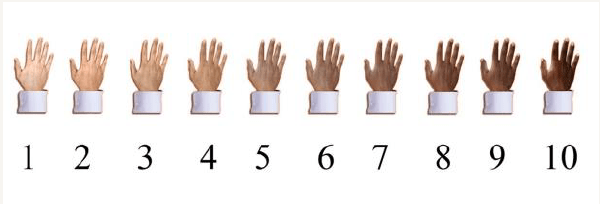
The most widely employed method to measure racial and ethnic identity is from the U.S. Census Bureau. It is a two-part question, first asking about Hispanic identity and then asking about racial identity and is the standard method used to measure racial and ethnic identity in decennial censuses and in surveys conducted by the bureau. It is also the standard often used by polling organizations, marketers, local governments and many others.
Alternative measures can capture other dimensions of racial and ethnic identity not necessarily captured by the Census Bureau’s format. For example, one’s skin color can shape opportunities and can be at the heart of discrimination experiences no matter what race one identifies with. In addition, how others see you, such as when passing each other on the street, can shape one’s life experiences. And sometimes directly asking one to describe their racial identity can reveal a personal view of identity unencumbered by the framing of survey questions.
Pew Research Center’s 2021 National Survey of Latinos explored four approaches to measuring racial identity – the Census Bureau’s two-question method; an assessment of how respondents believe others see them when passing them on the street (street race); an open-ended question asking respondents to describe their race and origin in their own words; and self-assessed skin color. Responses across all these measures do not necessarily align – a respondent may indicate their race is White in the Census Bureau’s method but also indicate their street race is Latino (and not White). These differences in responses reflect the nuances of racial identity, contextual factors and the experiences associated with them. This chapter explores these four alternative measures and the responses of Latino adults.
The Census Bureau’s standard method for measuring race and ethnicity
In current Census Bureau data collections like the 2020 decennial census and surveys like the American Community Survey, racial and ethnic identity is asked about in a two-part question. First, respondents are asked if they are Hispanic or Latino and then in a second question are asked their race. Currently, the Hispanic category is described in census forms and surveys as an ethnic origin and not a race with respondents given explicit instructions indicating so.
The Pew Research Center survey replicated the Census Bureau’s format, asking about race separately from Hispanic ethnicity. Asked about their race in this way, more than half of Hispanics in the survey identified their race as White (58%), with the next largest share selecting the “some other race” category (27%), 8% selecting two or more races, and 2% selecting Black or African American. Foreign-born Hispanics were more likely than their U.S.-born counterparts to select the “some other race” category, while U.S.-born Hispanics were more likely than foreign-born Hispanics to select multiple races. For both groups, though, more than half say their race is White.
These findings echo those of earlier Pew Research Center surveys of Hispanic adults, as well as Census Bureau findings from the 2010 decennial census and other surveys. Yet, the findings from this survey by the Center, conducted in March 2021, differ from those revealed by the Census Bureau from the 2020 decennial census. The wording of the 2020 Census race question differed markedly from the Center’s question and from previous decennial censuses surveys, which could account for why results varied greatly. In the 2020 census, for the first time respondents were prompted to write in origins or ethnicities for all racial groups; this was not offered to the Center’s survey respondents. According to the bureau, about four-in-ten Hispanics (42%) marked their race as “some other race” in the 2020 census without marking any other response, the single largest set of responses among the nation’s 62.1 million Hispanics—an analysis of the 2010 decennial census results showed that most responses coded as “some other race” were write-ins of Hispanic ancestries or ethnicities. This was followed by one-third (33%) who selected two or more racial groups, and 20% that selected White as their race. A separate Pew Research Center survey from 2020 found Hispanic adults were more likely than White or Black adults to say the 2020 decennial census two-part race and ethnicity questions do not reflect their identity well: 23% of Hispanic adults say census race and ethnicity questions reflect how they see their race and origin either “not too well” (17%) or “not at all well” (5%). This compares with 15% of White adults and 16% of Black adults who said the same.
Latinos’ skin color reflects the diversity within the group
For Latinos and non-Latinos alike, skin color is an important dimension of identity that can affect their daily lives. To measure this dimension of race, the survey asked Latino respondents to identify the skin color that best resembled their own using a version of the Yadon-Ostfeld scale. Respondents were shown 10 skin colors that ranged from fair to dark (see graphic below for images used). Eight-in-ten Latinos selected one of the four lightest skin colors, with the second-lightest ranking most common (28%), followed by the third (21%) and fourth lightest colors (17%). By contrast, only 3% of Latino respondents in total selected one of the four darkest skin colors.
For purposes of the analysis in this report, Hispanics are grouped into two categories. The “lighter skin” color group consisted of those who chose the four lightest skin colors (80%), while the “darker skin” color group included those who chose the six darker skin colors (15%). (Another 5% of respondents did not indicate their skin color.) While there were enough Hispanics who chose each of the lightest four skin colors to analyze separately, there were no significant differences in the opinions or experiences of discrimination among them due to their skin color. (The number of Hispanics who chose the five darkest skin tones was too small to analyze each separately.)
Among Latinos, those who rated their skin as lighter were more likely to be older than 50 (35%) than those who rated their skin as darker (23%). Latinos with lighter skin were also more likely to be women (52%) than Latinos with darker skin (42%).
Most Latinos say others would describe them as Latino when walking past them on the street
Similar to skin color, the way others perceive Latinos when interacting with them is another manner in how racial identity can be shaped. In the survey, respondents were asked how most people would describe them if they walked past them on the street.
Seven-in-ten Hispanic adults said that most people would describe them as Hispanic when walking past them on the street, with the foreign born the most likely to say this (75%) compared with those of the second generation (68%) or third or higher generation (55%).
Fewer than two-in-ten Latinos (17%) say others would view them as White when walking past them, with those born in the U.S. being more likely to say this (28% of at least third-generation Latinos and 20% of second-generation Latinos) than Latino immigrants (13%).
A smaller share (12%) say others view them as belonging to another racial group such as Asian, Black or Indigenous.
Asked to describe their race or origin, most Latinos say they are Hispanic or Latino or give their country of origin
As a fourth measure of racial identity, the survey asked Latinos how they would describe their race or origin in their own words. The most common responses for Latinos regarding their race in this open-end format were the pan-ethnic terms Hispanic, Latino or Latinx (28%) or responses that linked their racial origin to the country or region of their ancestors (28%). A smaller share also chose to identify their race or origin as American, either as a single answer or in combination with another response (11%), 9% identified their race as White, and 9% mentioned another racial group such as Asian, Black or Indigenous.
There were some differences in the way Hispanics identified their race depending on their immigrant roots. Fully one-third of the foreign born (33%) used the pan-ethnic terms Hispanic, Latino or Latinx to identify their race, while 23% of the U.S. born did so. Among the U.S. born, those with at least one immigrant parent – second generation Hispanics – were also more likely than those without any immigrant parents – third or higher generation – to use the pan-ethnic terms to describe their race (27% vs. 19% respectively).
Conversely, those born in the U.S., regardless of the place of birth of their parents, were more likely to describe their race or origin as American or having been born in the U.S. (19% of the U.S. born vs. 5% of the foreign born).
Those in the third or higher generation were more likely than those from the second generation to describe their race as White (14% vs. 6%). In addition, third or higher generation Hispanics were more likely than Hispanic immigrants or those with at least one immigrant parent to mention another racial group such as Black or Asian in their response (17% compared with 7% of foreign born and 8% of second generation).
How the four racial identity measures correlate with each other
There is some overlap in the responses to the four racial identity questions, particularly when looking at just two of the four measures. For example, nearly all respondents who say most people see them as White when passing them on the street (95%) chose one of the four lightest skin colors (1-4). By comparison, 79% of those who say they would be viewed as Latino by passersby selected one of the four lightest skin colors and 69% who say they would be perceived as belonging to another racial group did the same.
Similarly, 94% of those who said their race was White in the open-ended question chose one of the four lightest skin colors. About eight-in-ten (83%) of those who say they are Hispanic in the open-ended question or included a Hispanic country of origin or region (80%) also chose one of the four lightest skin colors. Meanwhile, 74% Hispanics who mentioned another racial group like Black or Asian selected one of the lighter skin colors.
Among Hispanics who characterized their race as White in the Census Bureau’s standard two-part question, 86% selected one of the four lightest skin colors. By comparison, about seven-in-ten of those who identified their race as “some other race” (72%) or chose another race group (68%) selected one of the four lightest skin colors.
There were other similarities across the ways respondents characterized their race across the four different questions included in the survey, but the overlap between similar categories across the four measures was considerably less. For example, among those who mark their race as White in a standard two-part race question, only 25% say others would describe them as such walking down the street, and only 14% describe their race as White in an open-ended question. In both measures, respondents who had selected their race as White in the Census Bureau’s standard two-part question were more likely to select Hispanic as the way others view them (69%) or use a pan-ethnic term (30%) or a country or Hispanic origin as their race (27%) when asked to describe their race in their own words.
The table shows the degree to which responses to the four different ways we asked about race correlate with each other. As can be seen, there is not much overlap across the four measures in the most common responses for these measures. When looking at the overlap across the four measures, only 5% of Hispanics identified their race as Hispanic or Latino in the open-ended question, said others viewed them as Hispanic when walking past them, selected the “some other race” option in a standard two-way format question and selected one of the four lighter skin colors of the 10 given. Similarly, only 4% of Hispanics described their race as White in an open-ended question, said others viewed them as White when walking past them, selected White in a standard two-way format question and selected one of the four lighter skin colors.
